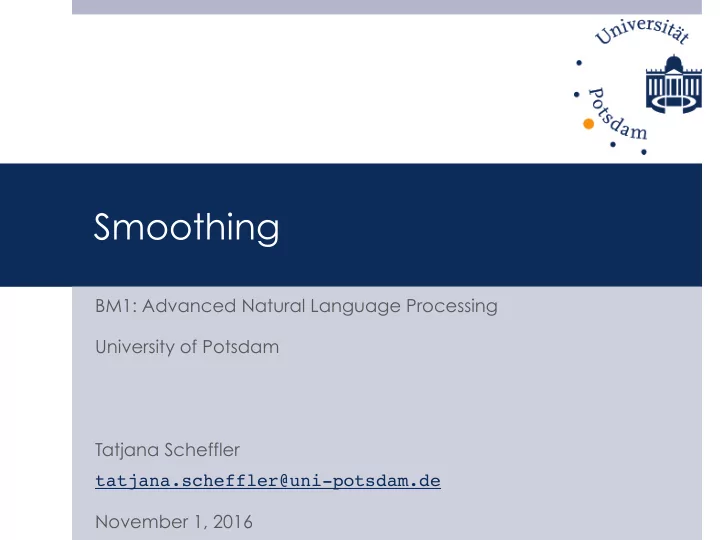

Smoothing BM1: Advanced Natural Language Processing University of Potsdam Tatjana Scheffler tatjana.scheffler@uni-potsdam.de November 1, 2016
Last Week ¤ Language model: P(X t = w t | X 1 = w 1 ,... ,X t-1 = w t-1 ) ¤ Probability of string w 1 … w n with bigram model: P(w 1 … w n ) = P(w 1 )P(w 2 |w 1 ) … P(w n |w n-1 ) ¤ Maximum likelihood estimation using relative frequencies: low n high n modeling errors estimation errors 2
Today ¤ More about dealing with sparse data ¤ Smoothing ¤ Good-Turing estimation ¤ Linear interpolation ¤ Backoff models 3
An example (Chen/Goodman, 1998) 4
An example (Chen/Goodman, 1998) 5
Unseen data ¤ ML estimate is “optimal” only for the corpus from which we computed it. ¤ Usually does not generalize directly to new data. ¤ Ok for unigrams, but there are so many bigrams. ¤ Extreme case: P(unseen|w k-1 ) = 0 for all w k-1 ¤ This is a disaster because product with 0 is always 0. 6
Honest evaluation ¤ To get an honest picture of a model’s performance, need to try it on a separate test corpus. ¤ Maximum likelihood for training corpus is not necessarily good for the test corpus. ¤ In Cher corpus, likelihood L(test) = 0. 7
Measures of quality ¤ (Cross) Entropy: Average number of bits per word in corpus T in an optimal compression scheme: ¤ Good language model should minimize entropy of observations. ¤ Equivalently, represent in terms of perplexity: 8
Smoothing techniques ¤ Replace ML estimate ¤ by an adjusted bigram count ¤ Redistribute counts from seen to unseen bigrams. ¤ Generalizes easily to n-gram models with n > 2. 9
Smoothing P(... | eat) in Brown corpus 10
Laplace Smoothing 11
Laplace Smoothing 12
Laplace Smoothing ¤ Count every bigram (seen or unseen) one more time than in corpus and normalize: ¤ Easy to implement, but dramatically overestimates probability of unseen events. ¤ Quick fix: Additive smoothing with some 0 < δ ≤ 1. 13
Cher example ¤ |V| = 11, |seen bigram types| = 11 ⇒ 110 unseen bigrams ¤ P lap (unseen | w i-1 ) ≥ 1/14; thus “count”(w i-1 unseen) ≈ 110 * 1/14 = 7.8. ¤ Compare against 12 bigram tokens in training corpus. 14
Good-Turing Estimation ¤ For each bigram count r in corpus, look how many bigrams had the same count: ¤ “count count” n r ¤ Now re-estimate bigram counts as ¤ One intuition: ¤ 0* is now greater than zero. ¤ Total sum of counts stays the same: 15
Good-Turing Estimation ¤ Problem: n r becomes zero for large r. ¤ Solution: need to smooth out n r in some way, e.g. Simple G-T (Gale/Sampson 1995): 16
Good-Turing > Laplace (Manning/Schütze after Church/Gale 1991) 17
Linear Interpolation ¤ One problem with Good-Turing: All unseen events are assigned the same probability. ¤ Idea: P*(w i | w i-1 ) for unseen bigram w i-1 w i should be higher if w i is a frequent word. ¤ Linear interpolation: combine multiple models with a weighting factor λ . 18
Linear interpolation ¤ Simplest variant: λ wi-1wi the same λ for all bigrams. ¤ Estimate from held-out data: ¤ Can also bucket bigrams in various ways and have one λ for each bucket, for better performance. ¤ Linear interpolation generalizes to higher n-grams. (graph from Dan Klein) 19
Backoff models ¤ Katz: try fine-grained model first; if not enough data available, back off to lower-order model. ¤ By contrast, interpolation always mixes different models. ¤ General formula (e.g., k=5): ¤ Choose α and d appropriately to redistribute probability mass in a principled way. 20
Kneser-Ney smoothing ¤ Interpolation and backoff models that rely on unigram models can make mistakes if there was a reason why a bigram was rare: ¤ “I can’t see without my reading ______” ¤ C 1 (Francisco) > C 1 (glasses), but appears only in very specific contexts (example from Jurafsky & Martin). ¤ Kneser-Ney smoothing: P(w) models how likely w is to occur after words that we haven’t seen w with. ¤ captures “specificity” of “Francisco” vs. “glasses” ¤ originally formulated as backoff model, nowadays interpolation 21
Smoothing performance (Chen/Goodman 1998) 22
Summary ¤ In practice (speech recognition, SMT, etc.): ¤ unigram, bigram models not accurate enough ¤ trigram models work much better ¤ higher models only if we have lots of training data ¤ Smoothing is important and surprisingly effective. ¤ permits use of “deeper” model with same amount of data ¤ “If data sparsity is not a problem for you, your model is too simple.” 23
Friday ¤ Part of Speech Tagging 24
Recommend
More recommend